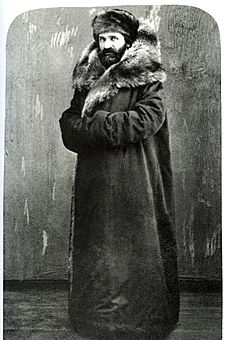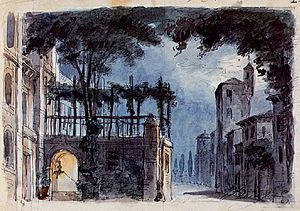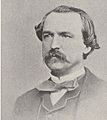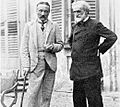Giuseppe Verdi facts for kids
Giuseppe Verdi was an Italian composer who wrote many famous operas. He was born in Roncole near Busseto on October 9 or 10, 1813, and died in Milan on January 27, 1901.
Verdi and Richard Wagner were two of the greatest opera composers of the 19th century. They had very different styles. When Verdi was young, Italian operas often followed the bel canto tradition. This meant they had beautiful tunes that let singers show off their voices, even if it didn't always fit the story. Verdi changed opera by making the story and drama the most important part. He used music to help tell the story, and his music is still known for its power and emotion.
Contents
Early Life and Musical Start
Giuseppe Verdi was born in a small village called Roncole, located in the Po valley in northern Italy. His family was not rich; his father ran a small inn and had a farm. From a young age, Verdi showed great talent for music. He received a spinet (a small keyboard instrument) which he kept his whole life. By age nine, he often played the organ for church services when the main organist was away.
A few years later, he started composing music for an amateur orchestra in Busseto. A kind man named Antonio Barezzi, who knew many important people, helped Verdi a lot. Verdi later married Barezzi's daughter. Barezzi sent him to Milan to study music. However, Verdi hadn't learned piano properly and wasn't accepted into the main music conservatory. He took private lessons instead and learned a lot about opera, literature, and politics.
In 1839, Verdi's first opera, Oberto, conte di San Bonifacio, was performed at La Scala, a famous opera house in Milan. This helped him become known, and he was asked to write three more operas for La Scala. Sadly, his next opera was not a success, and the audience didn't like it. During this difficult time, he also faced personal tragedy: his two children and his wife all passed away.
Rise to Fame
Verdi overcame his sadness in 1842 with his opera Nabucco. This opera was a huge success and made him famous around the world. He began working very hard, composing two operas each year. He not only wrote the music but also helped organize the performances. It was a massive amount of work. His opera Ernani (1844) was one of his best from this period. In 1847, he had another big success with Macbeth, based on Shakespeare’s famous play. Macbeth is still one of the most loved operas today.
For many centuries, Italy was divided into several smaller countries, each with its own ruler. In the 1850s, there was a lot of political unrest as people wanted Italy to become one united country. Verdi often wrote music for large choruses in his operas. The words of these choruses were often about fighting for freedom. People believed these songs encouraged them to revolt. For example, the song Va pensiero from Nabucco was about the Hebrew slaves held captive in Babylon. People would sing it in the streets, changing the words to fit their own desire for freedom. Verdi became a great national hero. Italy finally became one country in 1861.
Giuseppina Strepponi, a soprano singer, performed the role of Abigaille in Nabucco. Verdi fell in love with her, and they eventually married in 1859. She supported him greatly throughout their lives, even though Verdi could be a difficult husband. They moved back to Busseto, but Verdi often traveled without her, which made her unhappy because many people in Busseto didn't like her.
During this time, Verdi wrote three more famous operas: Rigoletto in 1851, and Il trovatore (The Troubadour) and La traviata, both in 1853. These operas contain many well-known tunes. They are full of exciting drama, and the characters are wonderfully brought to life by the music. Verdi changed how opera was structured, moving away from clear divisions between recitative (spoken-like singing) and aria (song). Instead, his music flowed continuously, with arias leading directly into the next musical section. He had a brilliant sense of drama and often had to fight with producers to keep his original ideas.
Verdi often had problems with the censors, who were officials who decided if an opera could be performed. His opera Rigoletto was based on a story by Victor Hugo where a king was almost murdered. This was not considered a suitable topic. Verdi had to change the king into a duke and make other changes before the opera could be performed.
International Success
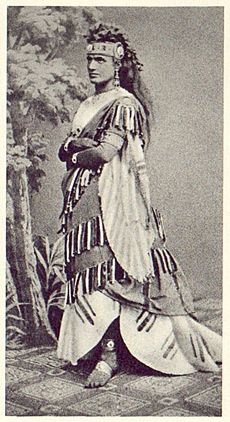
By now, Verdi was very famous and was asked to compose for the Opéra in Paris. He had to write operas in the French style, which meant they had five acts, a ballet, and a serious story. While these operas were good, his Italian works often showed more inspiration. Simon Boccanegra has a very complex plot, but the music beautifully describes the characters. Un ballo in maschera (The masked ball) was about the murder of King Gustav III of Sweden. Again, the censors didn't like it, and he had to change the story to take place in Boston, which somewhat spoiled the plot.
In the 1860s, some of his best works included La forza del destino (The Force of Destiny), written for St Petersburg, Don Carlos for the Paris Opéra, and Aida for the new opera house in Cairo, Egypt. Aida is considered one of his most perfect operas. Its first performance had some challenges, as Verdi had a long argument with the conductor Mariani, who refused to go to Cairo to conduct it.
Later Years and Legacy
Verdi retired in the 1870s. He was a wealthy man who owned a lot of land. He gave much of his money to charities, especially one that helped elderly musicians. Even in retirement, his publishers convinced him to write two more operas. He became very interested in Shakespeare and wrote Otello with a libretto (the text of an opera) by Arrigo Boito. This was a brilliant libretto, and it helped him create a masterpiece where every small detail of the story is beautifully expressed by the music. His very last opera, Falstaff (1893), was based on Shakespeare’s Merry Wives of Windsor. Verdi continued to write a few religious pieces in his old age. He died from a stroke in Milan in 1901.
Images for kids
-
Temistocle Solera, Verdi's first librettist.
-
Francesco Maria Piave whose work with Verdi included Rigoletto and La traviata
-
Arrigo Boito and Verdi at Sant'Agata in 1893
-
Group portrait at Sant'Agata in 1900 with various family and friends. His companion Teresa Stolz is standing at the left, Giulio Ricordi is standing second from the right, with his wife seated below him. Verdi is in the middle, and his adopted daughter, Maria Carrara Verdi, is seated at the far left.
-
Verdi conducting the Paris Opera premiere of Aida in 1880
See also
 In Spanish: Giuseppe Verdi para niños
In Spanish: Giuseppe Verdi para niños




